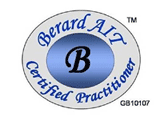What is Auditory Integration Training?
Auditory integration training (AIT) is an intervention developed by Dr. Guy Berard to correct or improve auditory hypersensitivity, distortions, and delays in the signals that interfere with an individual's ability to process auditory information normally. Inconsistencies and distortions in the way sounds are perceived can make it difficult to interpret auditory stimuli. In addition, Dr. Berard states that the ears must work together in a coordinated fashion. If the hearing in one ear is different from the other, the person may have auditory processing problems. This lack of coordination between the ears contributes to difficulties in following directions, comprehending what is said or read, and putting thoughts into words. Dr. Berard also states that some people hear certain frequencies much better than other frequencies. When this occurs, the person perceives sounds in a distorted manner, may be easily distracted, and may have difficulty understanding auditory information. According to Dr. Berard, these auditory problems are factors that contribute to disorders such as learning disabilities, attention deficit, dyslexia, hyperactivity, central auditory processing disorder, sensory processing disorder, autism and pervasive developmental disorder.
Who is a Candidate for Auditory Integration Training?
Individuals with learning and language disorders, sensory processing disorders, attention deficit, dyslexia, pervasive developmental disorder autism, central auditory processing disorders, and hearing sensitivity have been receiving AIT. The minimum age is 3 years, and there is no upper limit.
How is Auditory Integration Training Done?
The individual listens to music through headphones that is specially modified by the Earducator TM, or the Audiokinetron, the Berard devices designed for AIT. These devices modulate the music, and may be used to filter out specific frequencies. The training is provided for 30 minutes, twice a day for a total of 10 hours. Audio tests prior to training and after the first 5 hours of training indicate whether any specific filters may be used.
Is There a Home Program for Berard AIT?
Berard AIT is a center-based training program. Dr. Berard has not approved any home-based program at this time. The training should be provided under the direct supervision of the Berard Practitioner in order to achieve optimal results. The practitioner will be able to provide daily input and consultation to the parents based on feedback provided by the parents and clinical observations. Since clients may make significant changes during the 10 days of training due to the effectiveness of Berard AIT, parent consultation is a critical component of the program and can lead to better results.
How Do You Get the Child to Wear Headphones and Listen?
Proper preparation for the AIT program makes an important difference in the how well the child will cooperate with the procedures. Sally invests the time needed to help parents understand the steps to take so the child will understand what to expect. A variety of procedures that decrease sensitivity to wearing headphones are explained to parents so they can begin preparing the child for listening. Additional techniques are used during the program at our center so the children will be calm and feel safe. Children are not separated from their parents. Since 1992, only 4 children have not been able to accept the headphones for AIT. This is a remarkable record since many children are initially hesitant and very active.
What if the Person Can Not Cooperate to Obtain Audio Tests?
The Berard audio testing requires a mature level of concentration and communication. The audio testing provides information that is used in selecting whether a filter is needed during the training sessions, and therefore, must be accurate. For these reasons, Dr. Berard does not recommend this testing for children under 5 years old. If a person is not able to cooperate with audio testing, but seems to be a good candidate for AIT based on behavior and history, the training can be done without audio tests. Since the audio tests provide the basis for filter usage, no filters would be used. The modulated music has proven effective even without specific filters.
What Changes are observed after Auditory Integration Training (AIT)?
Reports from parents vary on how soon changes are noticed. At the IDEA Training Center, 73% of the parents observed positive changes during the actual 10 day training program. Some parents do not notice changes until a week, month or several months later. In some cases, progress may be subtle in the beginning, then become increasingly apparent as time goes by.
Parents often report a reduction in tantrums, sound sensitivity, echolalia, hyperactivity and impulsivity. Parents also observe increased ability in following directions, attention, auditory short-term memory, speech/language skills. Increased socialization, cooperation, self-confidence and independence are also frequently observed. Improvements in sensory processing, with a decrease in episodes of sensory overload are typically reported by parents.
You can also learn more about AIT Results and from Individual Comments from people who have benefited from AIT





